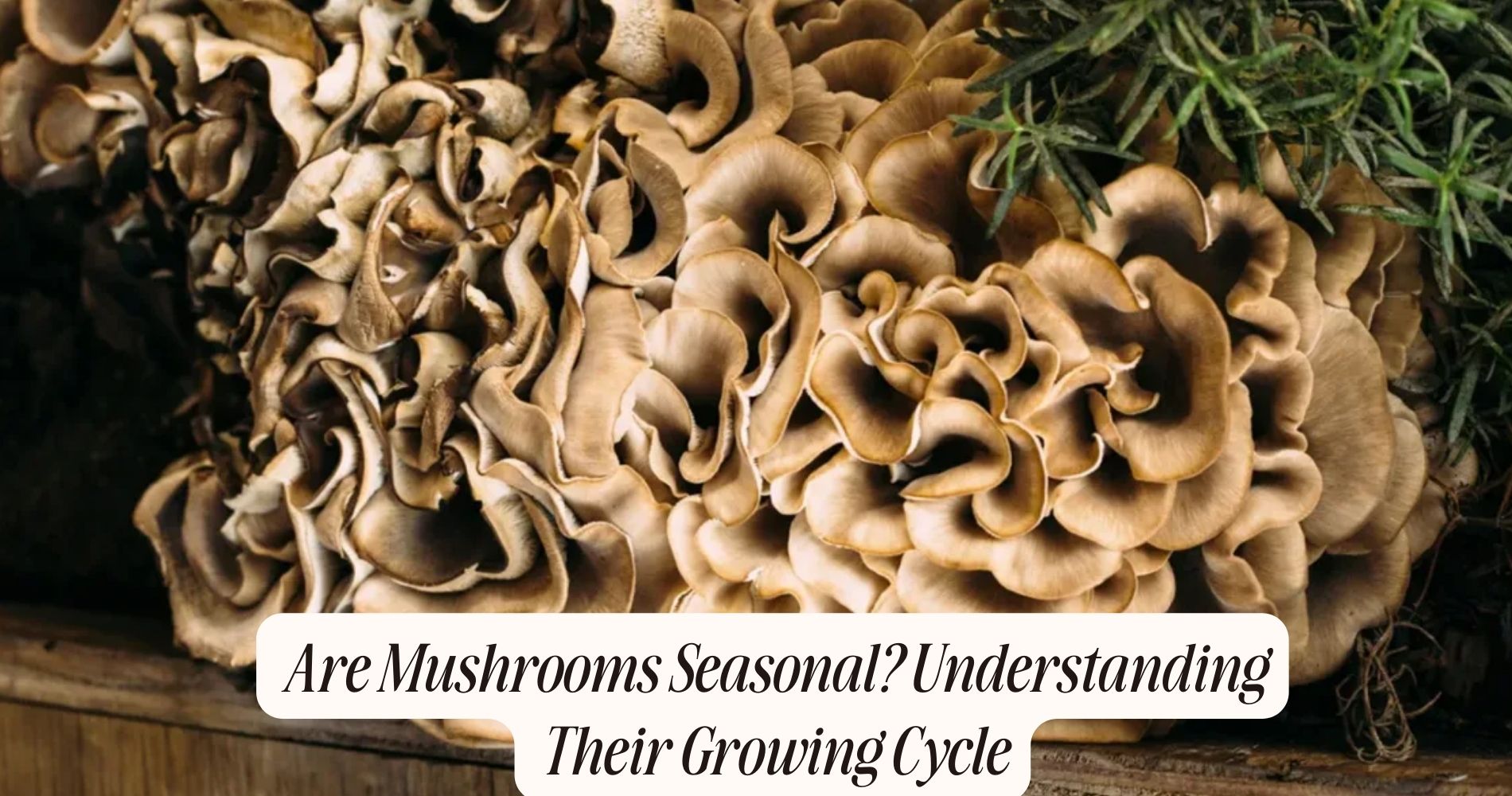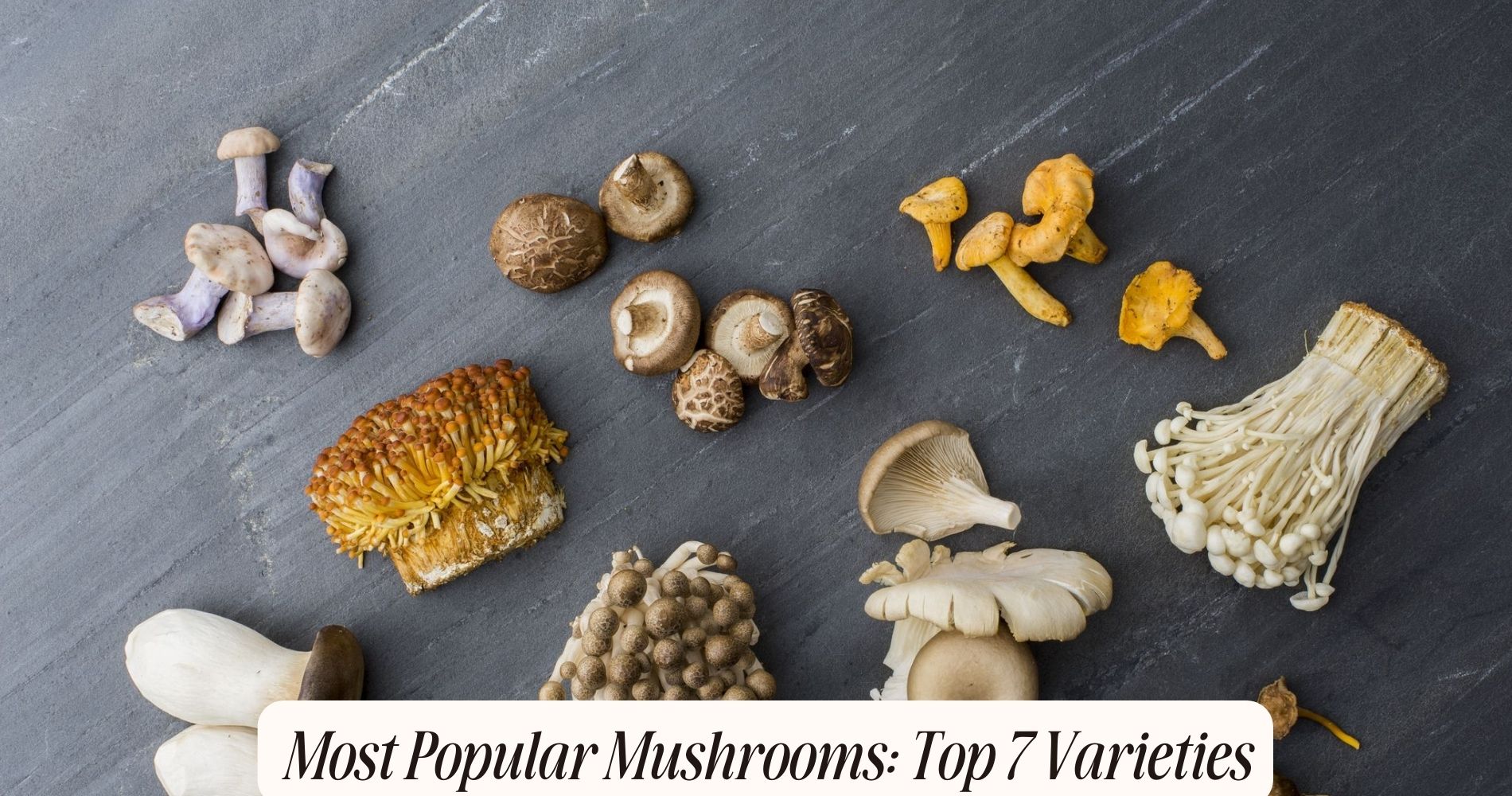
Are Mushrooms Seasonal? Understanding Their Growing Cycle
Are mushrooms seasonal? Mushrooms are indeed seasonal, thriving under specific environmental conditions such as temperature, humidity, and soil moisture. In spring, you'll find morels and oyster mushrooms, while summer sees chanterelles and boletes flourishing. Autumn brings a bounty of shiitake and oyster mushrooms. Each species prefers particular microclimates, with temperature ranges typically between 55°F and 60°F and humidity levels of 85% to 95%. Soil moisture at 60% to 75% is essential for healthy mycelial development. Indoor farming can produce mushrooms year-round in controlled environments, ensuring steady availability. Interested in detailed insights on foraging and cultivation? Your curiosity will be rewarded.
Wild Mushrooms and Seasons
The growth of wild mushrooms is intricately tied to the changing seasons, with each species having specific temperature and moisture requirements. You'll notice that certain mushrooms thrive in the cool, damp conditions of spring or fall, while others prefer the warmth of summer. By understanding these seasonal patterns, you can employ effective foraging techniques to locate and identify various species.
When foraging, it's essential to recognize the microclimates within larger ecosystems. For example, some mushrooms grow best in shaded, forested areas with rich, decaying organic matter, while others might prefer more open, grassy meadows. Be sure to use local guides and resources to refine your foraging techniques, making certain that you're searching in the right habitats during the correct seasons.

Mushroom conservation is equally important. Overharvesting can deplete local populations and disrupt the ecological balance. Always leave a portion of the mushrooms behind to allow for natural reproduction and promote future growth.
Common Seasonal Varieties
You'll observe that different mushroom species thrive in distinct seasons.
In spring, you'll find varieties like morels, while summer brings forth chanterelles.
Autumn is ideal for harvesting porcini mushrooms, reflecting the unique growing conditions of each season.
Springtime Mushroom Types
Springtime ushers in a variety of mushroom species, including the highly sought-after morels and vibrant oyster mushrooms. As a forager, spring mushroom foraging offers a unique opportunity to discover these edible spring varieties.
Morels, renowned for their honeycomb-like appearance, thrive in moist, forested areas, often near decaying elms, ash, and apple trees. Their symbiotic relationship with these trees allows them to absorb necessary nutrients, making them a prime target for foragers.
Oyster mushrooms, on the other hand, prefer growing on decaying wood, especially beech and aspen logs. These mushrooms are easily identified by their broad, fan-shaped caps and delicate gills, which run down the stem. They aren't only visually striking but also packed with nutrients, including protein, vitamins, and minerals.

Additionally, springtime also brings forth the appearance of St. George's mushrooms, named for their emergence around St. George's Day in late April. These mushrooms are often found in grassy areas, forming fairy rings. Their creamy-white caps and firm texture make them a delightful addition to springtime dishes.
Engaging in spring mushroom foraging requires a keen eye and knowledge of these edible spring varieties, ensuring a successful and rewarding experience.
Summer Fruiting Species
As summer unfolds, a diverse array of mushroom species, such as chanterelles and boletes, begin to fruit in various habitats. These edible species often thrive in warm, moist environments provided by summer rains and shaded forest floors. Chanterelles are particularly known for their vibrant yellow color and trumpet-like shape, while boletes are distinguished by their stout stems and sponge-like undersides.
To identify these summer fruiting species, focus on their unique morphological features. Chanterelles have false gills that appear as forked ridges, making them easily distinguishable from toxic look-alikes. Boletes, on the other hand, lack gills entirely and instead possess a porous layer beneath their caps.
The nutritional benefits of these mushrooms are remarkable. Chanterelles are rich in vitamins D and B, essential for bone health and energy metabolism, respectively. Boletes provide a good source of dietary fiber and antioxidants, contributing to digestive health and cellular protection. Including these mushrooms in your diet can enhance your nutritional intake considerably.
Understanding the growth patterns and habitats of summer fruiting species will enable you to forage responsibly and enjoy the many benefits these edible species offer.
Autumn Harvest Varieties
During autumn, a variety of mushrooms, including shiitake and oyster mushrooms, reach their peak growth, thriving in the cooler temperatures and increased humidity. These conditions provide the ideal environment for fungal growth, allowing these species to flourish.
Shiitake mushrooms are known for their meaty texture and rich, earthy flavors, which enhance many autumn dishes. You'll often find these mushrooms incorporated into soups, stews, and sautés, lending their robust autumn flavors to these hearty dishes.
Oyster mushrooms, on the other hand, have a delicate, slightly sweet taste that complements a variety of culinary uses. Preferring similar conditions, they grow on decaying wood and are often harvested in clusters. Their versatility makes them ideal for stir-fries, risottos, and even as a meat substitute in vegetarian dishes.
Shiitake mushrooms require a controlled environment with temperatures ranging from 50 to 80 degrees Fahrenheit and high humidity, often found naturally during autumn.

Environmental Factors
Understanding the environmental factors that influence mushroom growth is vital for optimizing cultivation conditions. Climate impact plays a significant role in determining the types of mushrooms that can thrive in a particular region. For instance, temperature and humidity levels are important. Mushrooms generally prefer cooler temperatures, ranging from 55°F to 60°F, and high humidity levels, around 85% to 95%. Variations in these parameters can drastically affect their growth rate and yield.
Soil moisture is another significant factor. Mushrooms rely on a substrate that maintains consistent moisture levels. Too much or too little moisture can hinder mycelial development and fruiting. You should aim for a substrate moisture content of approximately 60% to 75%. This balance guarantees that the mycelium can absorb enough water while preventing bacterial growth and substrate decomposition.
Moreover, air quality and light exposure also play a part. While mushrooms don't need sunlight for photosynthesis, light can influence their growth patterns. Controlled exposure to light can encourage proper fruiting, while clean, well-ventilated air prevents contamination.
Indoor Mushroom Cultivation
How can you efficiently manage an indoor mushroom cultivation setup to secure ideal growth conditions?
First, select the appropriate mushroom substrates. Common options include straw, sawdust, and coffee grounds. Each substrate type has specific nutritional profiles ideal for different mushroom species. Sanitizing the substrates is vital to prevent contamination. You can achieve this by pasteurizing or sterilizing them.
Next, maintain best indoor lighting conditions. Mushrooms generally require low to moderate light levels, replicating their natural, shaded environments. Use fluorescent or LED grow lights to provide consistent illumination without generating excessive heat. Position the lights to guarantee even distribution across your growing area.
Temperature and humidity control are also essential. Mushrooms thrive in temperatures ranging from 55-75°F, depending on the species. Use a thermostat to monitor and adjust the temperature as needed. High humidity levels, around 80-90%, are necessary for mushroom growth. Employ a humidifier and hygrometer to maintain these conditions.
Popular Cultivated Mushrooms
Among the most popular mushrooms cultivated for both culinary and medicinal purposes are Shiitake, Oyster, and Button mushrooms, each presenting unique growth requirements and benefits.
Shiitake mushrooms thrive on hardwood logs or sawdust, offering a robust, earthy flavor ideal for sautéing, grilling, and adding depth to broths. Rich in B vitamins, selenium, and polysaccharides, they're known for their immune-boosting properties.
Oyster mushrooms, favoring straw or wood substrates, exhibit a delicate texture and mild taste, making them versatile in various cooking techniques like stir-frying, roasting, and braising. Nutritionally, they provide protein, fiber, vitamins B and D, and antioxidants, supporting cardiovascular and immune health.
Button mushrooms, the most commonly grown, prefer composted manure and are notable for their mild flavor and firm texture. They're perfect for raw applications in salads or cooked in soups, sauces, and sautés.

These mushrooms are low in calories but high in essential nutrients like potassium, phosphorus, and vitamin D, making them a beneficial addition to your diet.
Year-Round Availability
You can guarantee mushrooms are available year-round through controlled environment farming, which precisely manages temperature, humidity, and light to simulate ideal growing conditions.
Additionally, imported mushroom varieties from regions with different growing seasons can supplement local production.
These methods create a consistent supply, regardless of seasonal changes.
Controlled Environment Farming
Leveraging advanced technology, controlled environment farming guarantees mushrooms are available year-round by meticulously regulating factors such as temperature, humidity, and light.
In modern mushroom farming, climate control systems are paramount. These systems allow you to create ideal growing conditions regardless of external weather patterns. By maintaining a stable temperature range between 55-60°F and a humidity level of 85-90%, you guarantee a consistent yield.
Light exposure is another critical factor. Mushrooms require minimal light to thrive, often simulating the low-light conditions of their natural forest floor habitats. Advanced LED systems can be programmed to deliver precise light wavelengths, enhancing mushroom growth and development.
The use of automated irrigation and ventilation systems further refines the environment. Automated irrigation guarantees consistent moisture levels in the substrate, critical for mycelium health. Simultaneously, ventilation systems help control CO2 levels, preventing any detrimental buildup that could hinder mushroom growth.
Imported Mushroom Varieties
Thanks to globalization and advanced logistics, you can now access a diverse array of imported mushroom varieties year-round, enriching culinary options and nutritional profiles.
Imported species like Shiitake from Japan, Porcini from Italy, and Enoki from Korea are no longer confined to their native growing seasons. This constant availability in global markets allows for more consistent menu planning and nutritional intake.
When considering imported species, it's vital to understand their unique growing requirements and how these are met in their countries of origin. Advanced farming techniques and climate-controlled environments allow these mushrooms to be grown continuously, regardless of external weather conditions.
For instance, Shiitake mushrooms are cultivated on special hardwood logs or sawdust blocks, optimized for year-round production.

Global markets play an important role in ensuring these mushrooms reach your local grocery stores. Efficient supply chains, including cold storage and rapid transportation, maintain the freshness and quality of the mushrooms.
This logistical efficiency enables you to enjoy the flavors and health benefits of a wide range of mushrooms, such as antioxidants from Shiitake or the high fiber content in Enoki, irrespective of the season.
Choosing Seasonal Mushrooms
Identifying seasonal mushrooms requires an understanding of their specific growing conditions and the time of year they thrive. Start by researching local climate patterns and natural habitats. For example, morels typically appear in spring, while chanterelles favor summer and fall. Use mushroom foraging tips like checking forested areas after rainfall, when many fungi species tend to fruit.
To choose the best seasonal mushrooms, look for indicators such as temperature and moisture levels. Spring mushrooms like morels thrive in cool, moist environments, whereas fall varieties like maitake prefer cooler, dry conditions. When foraging, carry a field guide to help you accurately identify edible species and avoid toxic look-alikes.
After collecting your seasonal bounty, you can explore seasonal mushroom recipes to make the most of your harvest. For instance, incorporate spring morels into a creamy pasta dish or sauté summer chanterelles with fresh herbs.
Enhance Your Season with SUPER MUSHROOM GUMMIES
While delving into whether mushrooms are seasonal, you can enjoy their benefits year-round with SUPER MUSHROOM GUMMIES by Well Gummies. These convenient, chewable gummies are infused with 10 types of functional mushrooms, designed to naturally fuel your brain and energize your body. Vegan and deliciously flavored with fresh wild berries, they provide sustained energy, sharp focus, and robust immune support without jitters or crashes. Make SUPER MUSHROOM GUMMIES a daily part of your wellness routine to maintain a balanced body and a clear mind, regardless of the season.
Frequently Asked Questions
How Do Mushrooms Reproduce?
Mushrooms reproduce through spore dispersal, where spores are released into the environment. Once the spores find a suitable substrate, they germinate and form mycelium networks, which are the vegetative structures that grow and eventually produce mushrooms.
Are There Any Poisonous Seasonal Mushrooms?
Yes, you'll find toxic varieties of mushrooms that appear seasonally. Spring and fall are peak times for these hazardous fungi. Recognize the seasonal risks and always identify mushrooms accurately to avoid poisoning.
Can Mushrooms Be Frozen for Later Use?
You can preserve mushrooms using freezing methods. Clean and slice them before blanching to preserve texture and flavor. This mushroom preservation technique guarantees they remain usable for months, retaining most of their nutritional value.
What Nutrients Do Seasonal Mushrooms Provide?
When examining nutrient profiles, seasonal mushrooms provide vitamins, minerals, and antioxidants. They offer health benefits like improved immunity and reduced inflammation. You'll find essential nutrients such as vitamin D, B-vitamins, selenium, and potassium in them.
How Do You Identify Wild Mushrooms Safely?
To safely identify wild mushrooms, focus on edible varieties. Use identification tips like checking cap shape, gill color, and spore print. Always cross-reference with a reliable field guide, and never consume uncertain specimens.
Conclusion
By understanding mushrooms' growing cycles, you'll appreciate their seasonal nuances. Wild varieties thrive in specific conditions, while indoor cultivation guarantees steady availability.
Recognizing environmental factors and choosing seasonally can enhance your culinary experiences. With cultivated mushrooms, you've got a consistent supply, but don't overlook the unique flavors of seasonal wild mushrooms.
By integrating both, you can enjoy the diverse tastes and benefits mushrooms offer year-round. Make informed choices to elevate your dishes and nutrition.




